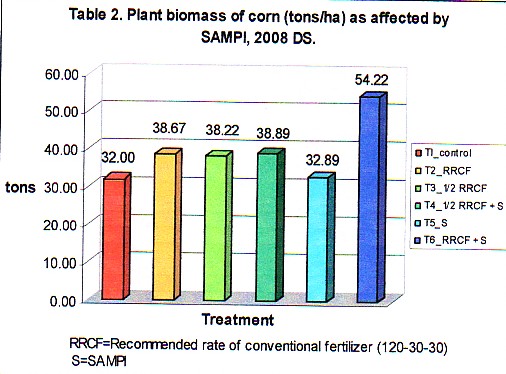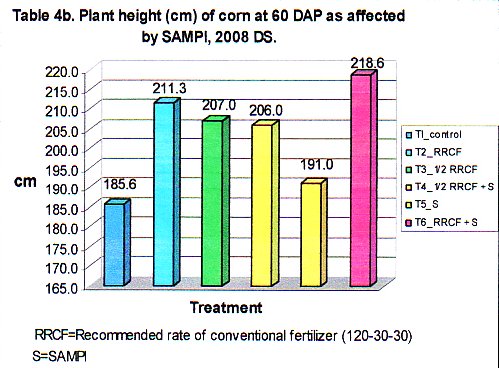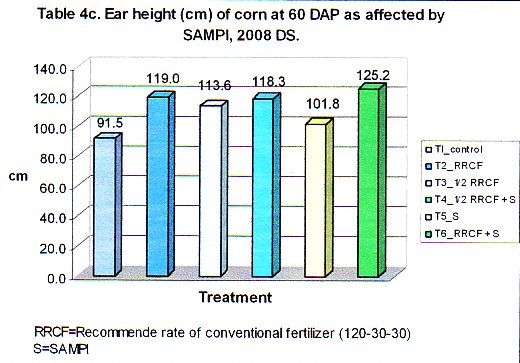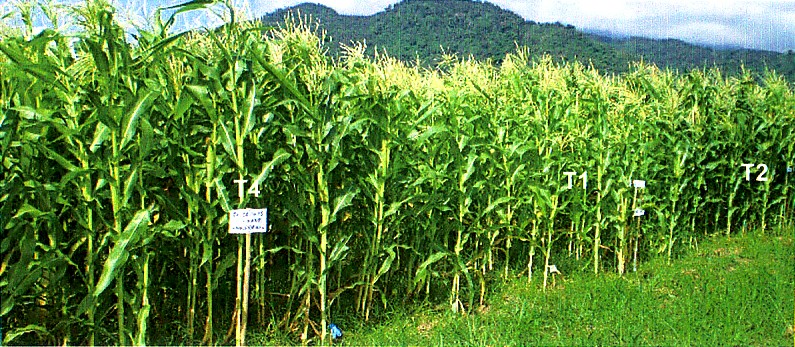 Aquasate
Aquasate

| Nitrogen (N) | 3.1 % |
| Phosphorus (P205) | 0.64% |
| Potassium (K2O) | 0.34% |
| Calcium (Ca) | 0.18% |
| Magnesium (Mg) | 0.05% |
| Sulfur (S) | 0.34% |
| Zinc (Zn) | 43.9 ppm |
| Manganese (Mn) | 2 ppm |
| Iron (Fe) | 184 ppm |
| Boron (B) | 37.5 ppm |
| Molubdenum (Mo) | 0.08 ppm |
| Copper (Cu) | 26 ppm |
| REP 4 | T4 | T1 | T3 | T6 | T2 | T5 |
| REP 3 | T3 | T5 | T4 | T2 | T1 | T6 |
| REP 2 | T1 | T4 | T2 | T5 | T6 | T3 |
| REP 1 | T5 | T3 | T6 | T4 | T1 | T2 |
| Plots are 5 meters x 4 meters with 1 meter between rows. | ||||||
| Treatment | REPLICATION | MEAN | |||||
| 1 | 2 | 3 | 4 | ||||
| T1 control | 3.25 | 2.71 | 3.33 | 3.75 | 3.26 | B | |
| T2 RRCF | 6.46 | 7.04 | 5.27 | 7.14 | 6.48 | A | |
| T3 ½ RRCF | 6.19 | 7.35 | 5.52 | 5.74 | 6.2 | A | |
| T4 ½ RRCF + H | 6.67 | 5.14 | 6.21 | 6.86 | 6.22 | A | |
| T5 H | 4.47 | 4.72 | 4.38 | 4.35 | 4.48 | B | |
| T6 RRCF + H | 7.15 | 7.82 | 7.36 | 7.14 | 7.37 | A | |
| RRCF = Recommended Rate of Conventional Fertilizer, 120-30-30 H = Tuna Hydrolysate |
|||||||
| Treatment | REPLICATION | MEAN | ||||
| 1 | 2 | 3 | 4 | |||
| T1 control | 32.00 | 30.67 | 38.67 | 26.67 | 32.00 | B |
| T2 RRCF | 38.67 | 33.33 | 30.67 | 52.00 | 38.67 | B |
| T3 ½ RRCF | 38.22 | 38.67 | 36.00 | 40.00 | 38.22 | B |
| T4 ½ RRCF + H | 41.33 | 36.00 | 38.89 | 39.33 | 38.89 | B |
| T5 H | 32.89 | 21.33 | 42.67 | 34.67 | 32.89 | B |
| T6 RRCF + H | 60.00 | 53.33 | 54.22 | 49.33 | 54.22 | A |
| RRCF = Recommended Rate of Conventional Fertilizer, 120-30-30 H = Tuna Hydrolysate |
||||||
| Treatment | REPLICATION | MEAN | ||||
| 1 | 2 | 3 | 4 | |||
| T1 control | 6332 | 8000 | 7000 | 4000 | 6333 | D |
| T2 RRCF | 26168 | 31000 | 21000 | 26500 | 26167 | A |
| T3 ½ RRCF | 17000 | 19500 | 16000 | 15500 | 17000 | BC |
| T4 ½ RRCF + H | 16500 | 29500 | 22332 | 21000 | 22333 | AB |
| T5 H | 8668 | 6500 | 7000 | 12500 | 8667 | CD |
| T6 RRCF + H | 30668 | 39000 | 32000 | 21000 | 30667 | A |
| RRCF = Recommended Rate of Conventional Fertilizer, 120-30-30 H = Tuna Hydrolysate |
||||||
| Treatment | REPLICATION | MEAN | ||||
| 1 | 2 | 3 | 4 | |||
| T1 control | 74.2 | 77.7 | 73.1 | 71.9 | 74.2 | B |
| T2 RRCF | 99.1 | 109.5 | 98.7 | 100.4 | 101.9 | A |
| T3 ½ RRCF | 108.7 | 114.3 | 98.4 | 94 | 103.9 | A |
| T4 ½ RRCF + H | 106.5 | 101.5 | 87.5 | 93.6 | 97.3 | A |
| T5 H | 91.9 | 72.2 | 79 | 75.1 | 79.5 | B |
| T6 RRCF + H | 106.7 | 105.4 | 113.1 | 101.8 | 106.8 | A |
| RRCF = Recommended Rate of Conventional Fertilizer, 120 - 30 - 30 H = Tuna Hydrolysate |
||||||
| Treatment | REPLICATION | MEAN | ||||
| 1 | 2 | 3 | 4 | |||
| T1 control | 186.0 | 196.3 | 188.2 | 172.0 | 185.6 | C |
| T2 RRCF | 209.2 | 213.3 | 210.0 | 212.8 | 211.3 | AB |
| T3 ½ RRCF | 199.2 | 220.0 | 203.0 | 205.8 | 207.0 | B |
| T4 ½ RRCF + H | 197.3 | 213.3 | 210.0 | 203.3 | 206.0 | B |
| T5 H | 181.7 | 187.3 | 199.0 | 196.0 | 191.0 | C |
| T6 RRCF + H | 217.5 | 211.2 | 225.8 | 220.0 | 218.6 | A |
| RRCF = Recommended Rate of Conventional Fertilizer, 120 - 30 - 30 H = Tuna Hydrolysate |
||||||
| Treatment | REPLICATION | MEAN | ||||
| 1 | 2 | 3 | 4 | |||
| T1 control | 97.3 | 91.5 | 89.5 | 87.8 | 91.5 | B |
| T2 RRCF | 115.5 | 125.3 | 113.7 | 121.7 | 119.0 | A |
| T3 ½ RRCF | 109.2 | 123.0 | 106.5 | 115.8 | 113.6 | A |
| T4 ½ RRCF + H | 114.8 | 117.5 | 122.7 | 118.3 | 118.3 | A |
| T5 H | 92.8 | 99.5 | 103.0 | 112.0 | 101.8 | B |
| T6 RRCF + H | 134.2 | 118.7 | 131.7 | 116.2 | 125.2 | A |
| RRCF = Recommended Rate of Conventional Fertilizer, 120 - 30 - 30 H = Tuna Hydrolysate |
||||||
 |
 |
 |
 |
 |
 |
|
T1. Control T2. Rec. Rate inorg. Fert (120-30-30) T3. ½ RRIF T4. ½ RRIF + Rec. Rate of Tuna Hydrolysate Liquid Fertilizer T5. RRSF T6. RRIF + RRSF |
 |
 | |
| Figure 5. Growth of sweet corn treated with Tuna Hydrolysate at 60 DAP. | |
|
T1. Control T2. Rec. Rate inorg. Fert (120-30-30) T3. ½ RRIF T4. ½ RRIF + Rec. Rate of Tuna Hydrolysate Liquid Fertilizer T5. RRSF T6. RRIF + RRSF |
 |
 | |
| Figure 6. Growth of sweet corn treated with Tuna Hydrolysate at 60 DAP. | |
|
T1. Control T2. Rec. Rate inorg. Fert (120-30-30) T3. ½ RRIF T4. ½ RRIF + Rec. Rate of Tuna Hydrolysate Liquid Fertilizer T5. RRSF T6. RRIF + RRSF |
 |
 | |
| Figure 7. Growth of sweet corn treated with Tuna Hydrolysate at 60 DAP. | |
